Danish Rye Bread (Rugbrød)
This post may contain affiliate links. See my disclosure policy.
This authentic Danish rye bread recipe (rugbrod) is easier to make than you may think. It’s packed with nutrients, has a fantastic texture and old-fashioned flavor and is just plain delicious! Whether you prefer a bolder or milder flavor, you’re completely in charge of that in determining how long you allow the batter to ferment.
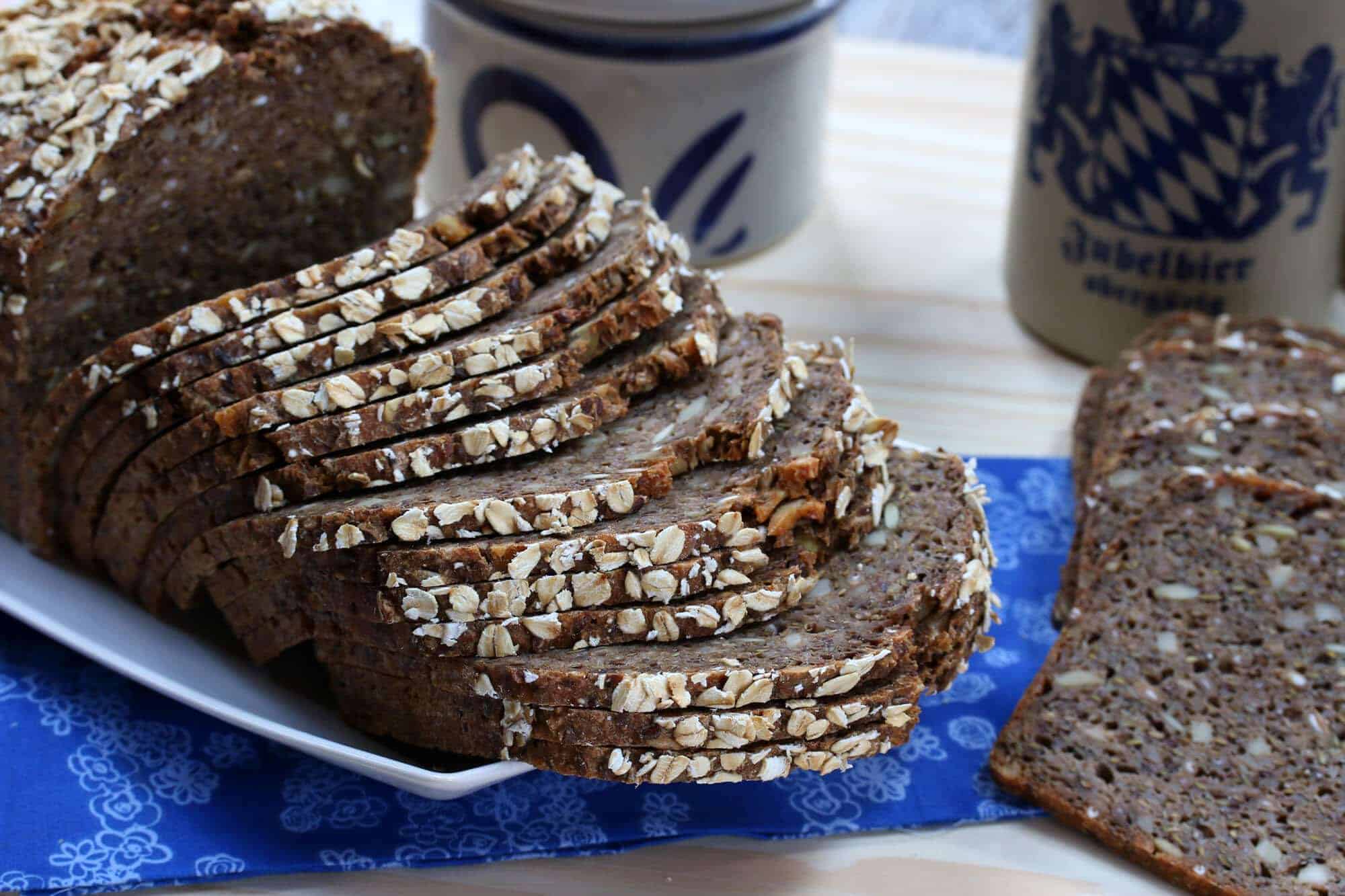
I love breads of all kinds, but there are two kinds that I especially love: Ones that are perfectly crispy on the outside and fluffy on the inside (eg, baguettes) and whole grain breads that are very dense and hearty like the kind I grew up with in Germany (eg, Vollkornbrot, Roggenbrot, Schwarzbrot, etc) and this Danish rye bread.
Smorrebrod
In Germany and throughout Scandinavia dense whole grain breads are particularly popular. You’ll see them served cut up in squares for a variety of hors d’oeuvres (for example, topped with gravlax/smoked salmon, a dollop of crème fraîche or hard-boiled eggs and a sprig of dill), served for breakfast with a tray of sliced cheeses and cold cuts, enjoyed for open-faced sandwiches or simply slathered down with good butter and jam.
In Denmark this rye bread (rugbrød) serves as the basis for their smørrebrød (ie, smorgasbord) wherein it is served buffet style with any number of fine toppings and is also a common accompaniment for many meals. Traditional options include herring, pickled vegetables, liver pate, smoked salmon, and sliced hard-boiled eggs. This Danish Rye Bread recipe is just what you need to create your smorrebrod!
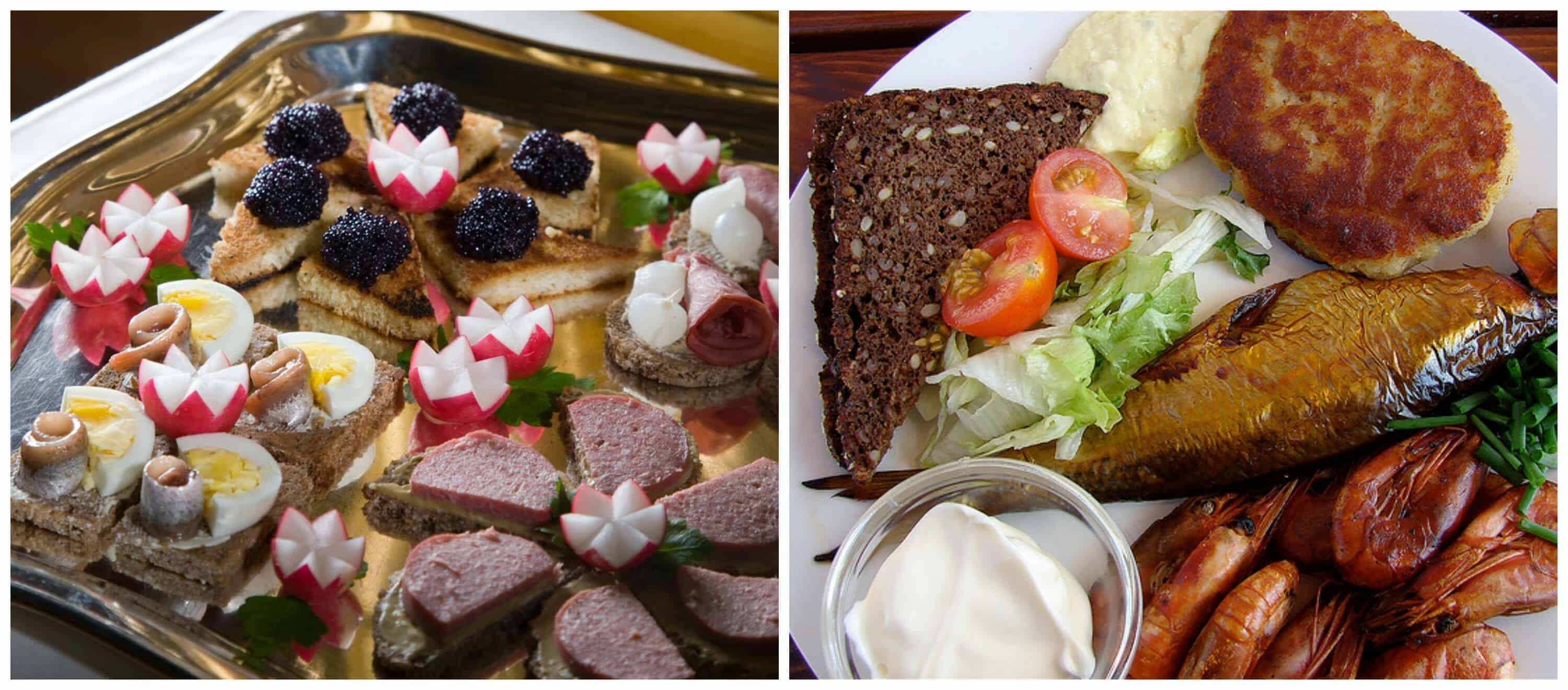
I’ve known many people who have visited Denmark or Germany, fell in love with this type of bread and returned home to their countries unable to find it there. I haven’t been able to find it anywhere here in the U.S. except for German specialty stores and World Market stocks a very small selection of dense German breads. Though specifically Danish sourdough rye bread I haven’t found anywhere here for purchase. The good news is you can make it yourself and I’m going to be posting several recipes for this wonderful style of dense, hearty European bread.
We’re going to start with a favorite among many, Danish Rye Bread. And while this bread is also popular in Germany, it claims particular importance in Denmark, indeed it’s practically one of its national foods, so we’re going to go ahead and ascribe this bread to the Danes. (Plus it will make the maternal side of my husband’s family happy, they’re fiercely proud of their Danish ancestry. And I have some Danish ancestry myself, so we’re all happy.)
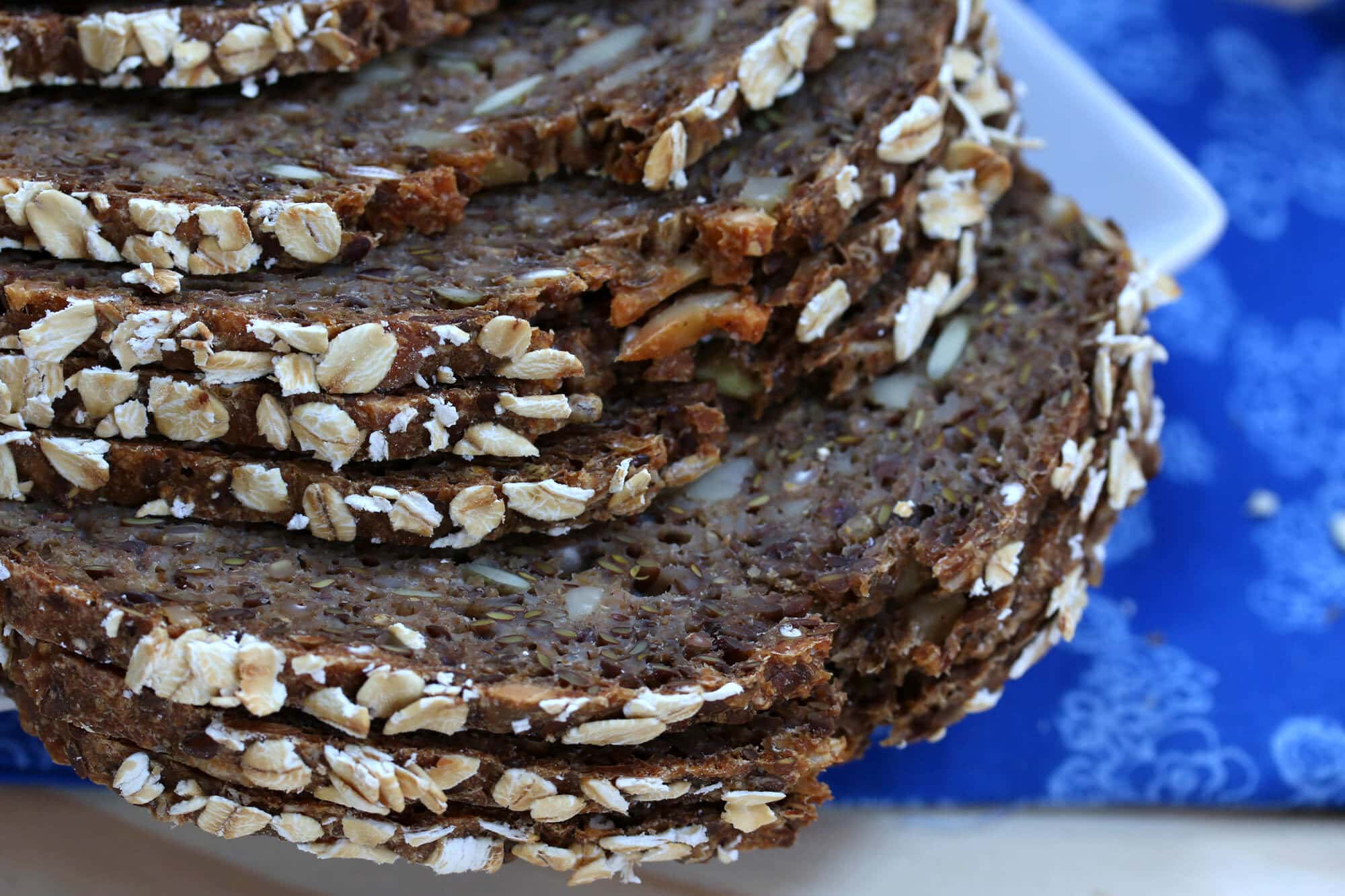
How to Make Danish Rye Bread
Danish rye bread is a sourdough bread that traditionally takes 2-3 days to make. Here is a super simple version that cuts the fermentation time down to as a little as 24 hours without the need to tend and feed it. This version calls for a yeasty beer. Beer and bread are cousins, both traditionally made from the same two ingredients, water and grains. The alcohol in this bread is burned off during the long baking process while the beer contributes to a fabulous texture and consistency (and flavor, depending on which beer you use).
The bread dough is allowed to ferment for 24 hours at room temperature (or 48 hours depending on how sour you like the bread). This fermentation process neutralizes the phytic acid in the grains, a naturally occurring substance that binds nutrients so that the body cannot properly absorb them. Not only does phytic acid acid bind the nutrients of the grains themselves, it binds the nutrients of anything else you eat with the grains. Fermenting the bread dough increases its nutrients and makes the bread easier to digest. And even after sourdough is baked it continues to sour and only gets better in flavor over time.
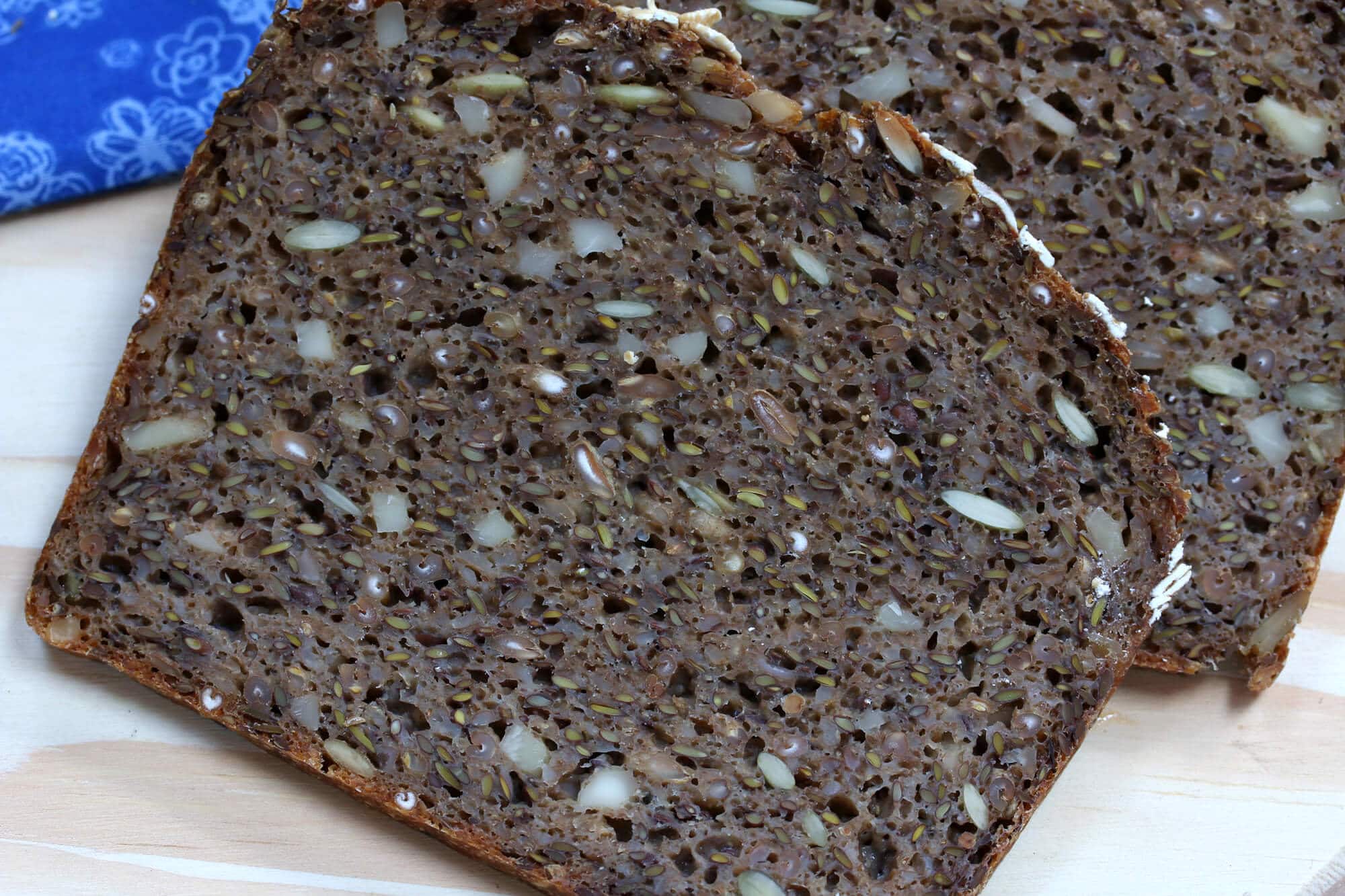
Danish Rye Bread Ingredients
This wonderfully nourishing bread is packed full of whole grains, seeds and nuts. The grains are included in the form of flour (rye and wheat), cracked rye berries and whole rye berries. Tons of similar styled breads incorporate these various forms of whole, cracked, coarsely ground and finely ground grains (eg, spelt, einkorn, wheat, kamut, etc) into the same loaf for a wonderful balance of textures, and that’s where a good grain mill really comes in handy. Not only can you grind your own fresh flour on demand with all the nutrients still intact (as opposed to flour that’s been sitting on grocery store shelves for ages), you can get exactly the kind of grind you need.
I buy my grains all in bulk, take out what I need to last me for a few weeks at a time and store the rest in a dark, cool place. I don’t even buy flour anymore, I grind all of my own flours, cornmeal and make my own baking mixes. For today’s Easy Danish Rye Bread I’m using my German-made KoMo Classic Grain Mill, another stellar example of German engineering and the pride and joy of my kitchen.
With a 12-year warranty, the quality and construction of the KoMo is amazing, plus it’s gorgeous and something you’d want to display on your counter. You can grind your grains as fine or coarse as you like. I use it nearly every day to make my own flours, cornmeal and mixes and cannot recommend it highly enough.
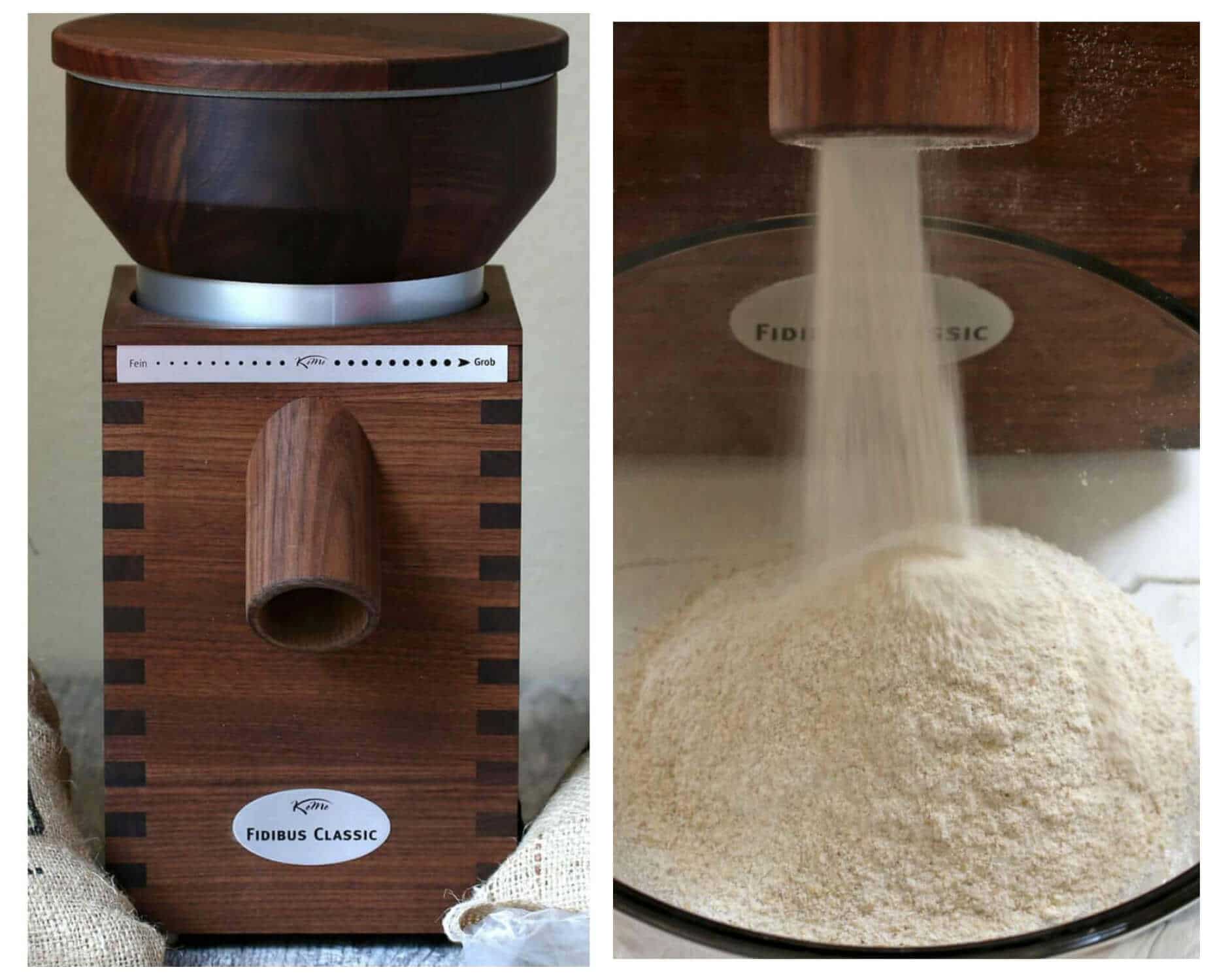
Check out my video below where I talk about some of the KoMo Classic Grain Mill’s features and show it in action in making today’s Danish Rye Bread!
Danish Rye Bread Recipe
Let’s get started!
If you’re grinding your own rye and wheat flour and cracking your own rye berries you’re in great shape! If you don’t have a grain mill you can easily find rye flour in grocery stores and you can “crack” the rye berries yourself by very briefly pulsing them in a good/powerful blender or food processor or smashing them in a bag with a meat mallet or other heavy object.
Combine all of the dry ingredients in a stand mixer bowl. Stir the yeast and sugar into the warm water and let sit for 10 minutes. Add all the wet ingredients to the dry ingredients.
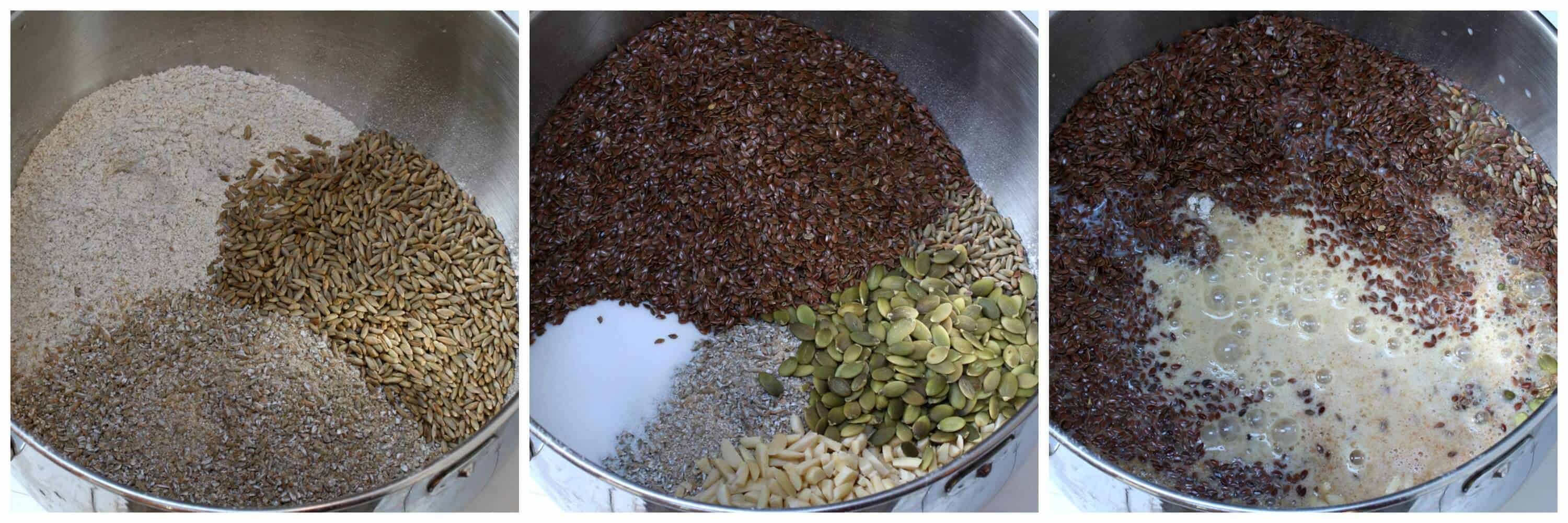
Give everything a stir manually to combine, then attach the dough hook on the stand mixer, set it to the bread setting (#2), and knead for 10 minutes. The dough will be very sticky, loose and not remotely malleable (ie, incapable of being shaped).
Scoop the dough into a very large non-metallic bowl. The dough will bubble up so use a very large, deep bowl with plenty of head room. Cover the dough loosely with plastic wrap and set it in a warm place (ie, room temperature) for 24-48 hours, depending on how sour you want the bread. I’ve done both with great results. If you’re only letting it ferment for 24 hours we recommend first soaking the whole rye berries overnight before using them (drain thoroughly).

After 24 hours the dough will be nice and bubbly with a very gooey texture.
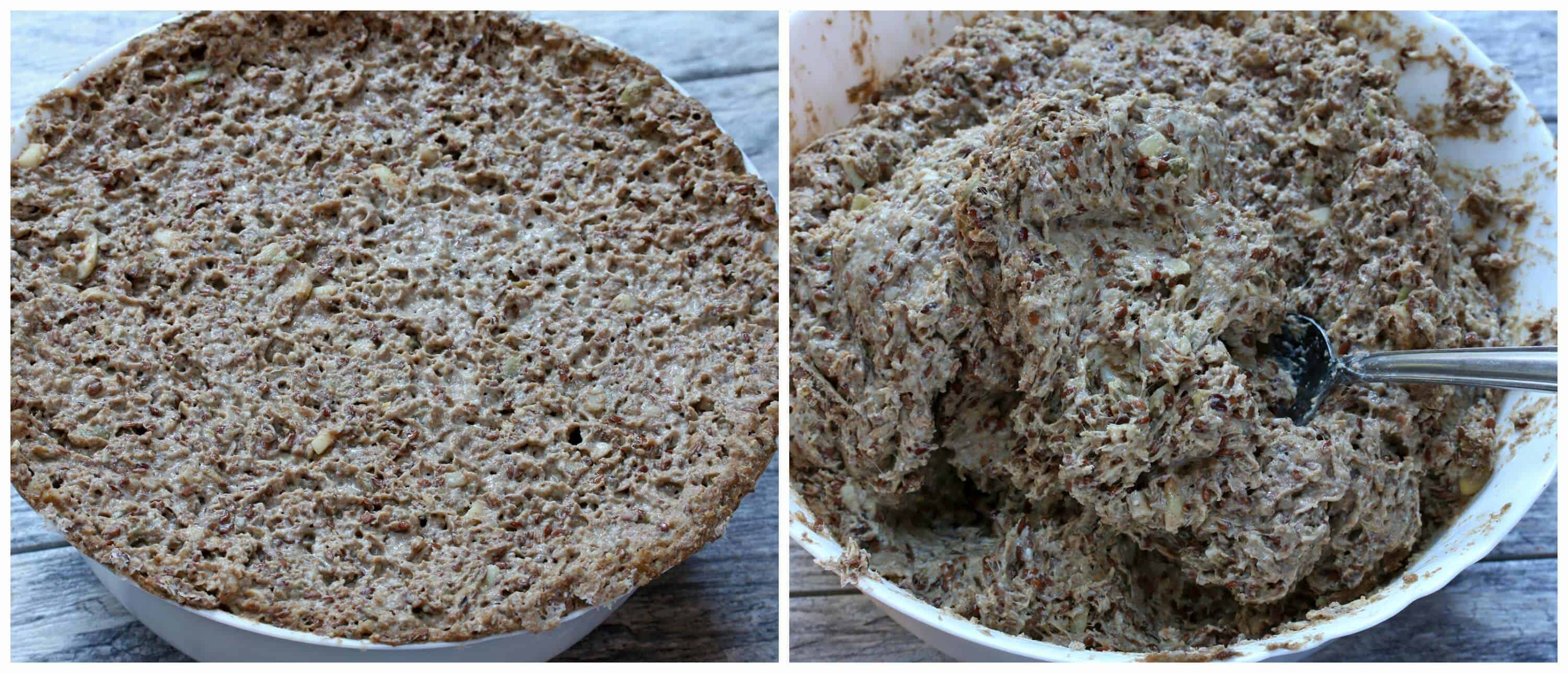
For sourdough it’s recommended that you line your loaf pans so the acid in the dough can’t react with the metal. I use and love the Parrish Magic Line bread pan made of heavy gauge aluminum with straight edges (made in the USA). It’s a 9 x 5 x 3 inch loaf pan.
Scoop all of the dough into the loaf pan, patting it down. It’s a lot of dough but it’ll fit in there, just pat it down (be sure you’re using a 9x5x3 loaf pan). Brush the top with some water and sprinkle some oats evenly over it.

Bake at 350 degrees F for 100-120 minutes or until the center is done. For best and most accurate results use an instant read thermometer and aim for an internal temperature of at least 210 degrees F.
Let it sit for 5 minutes before removing it from the pan. Let the bread cool completely before slicing it. Your rugbrod is ready!
To prolong its shelf life I recommend storing it in the refrigerator or freeze part of it if you know it will take you a while to go through it.
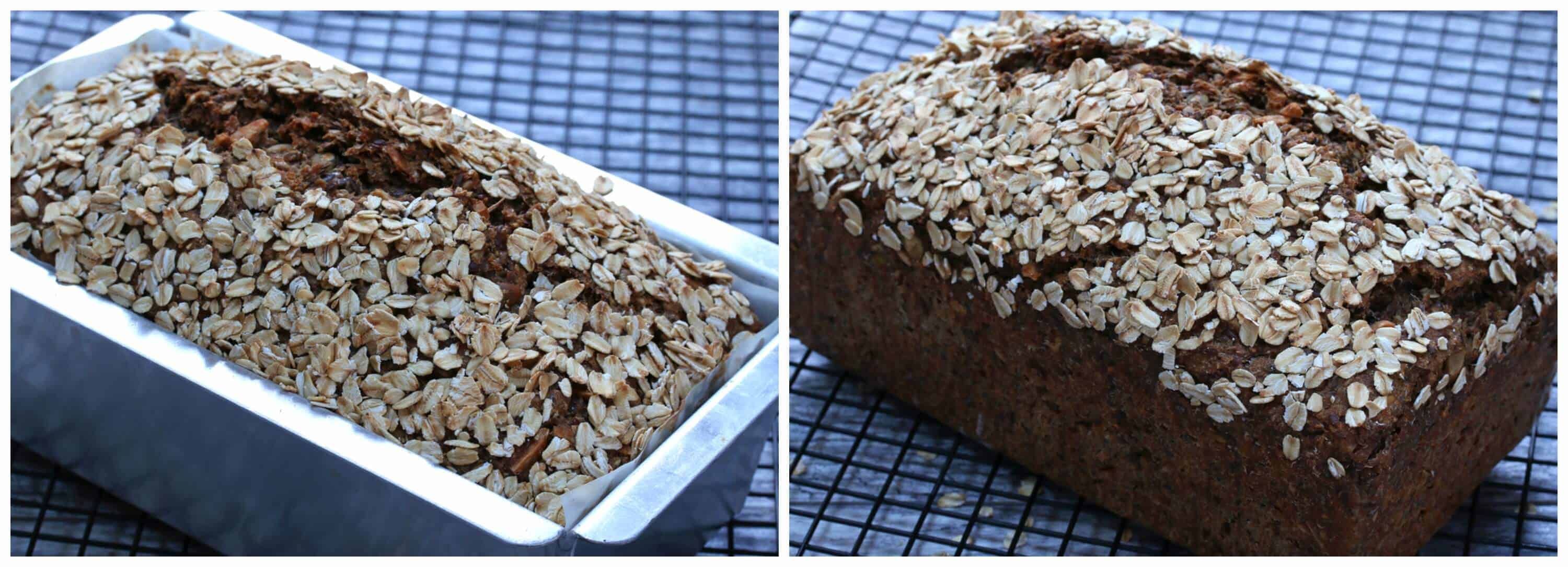
In order to get nice thin, clean slices that look like something you bought at a professional bakery, I recommend a slicer. Chef’s Choice Slicers are consistently ranked at the top and they get excellent reviews. I also use a slicer for meats and cheeses. Whenever I find chunks of cooked ham, turkey or cheese on sale I get those and slice them myself – it’s cheaper than buying them at the deli. At the very least you’ll need an excellent bread knife and for that my favorite knife, hands down, is the Cutco 9 3/4″ Slicer. It glides smoothly through bread and meat like no other.
Enjoy!
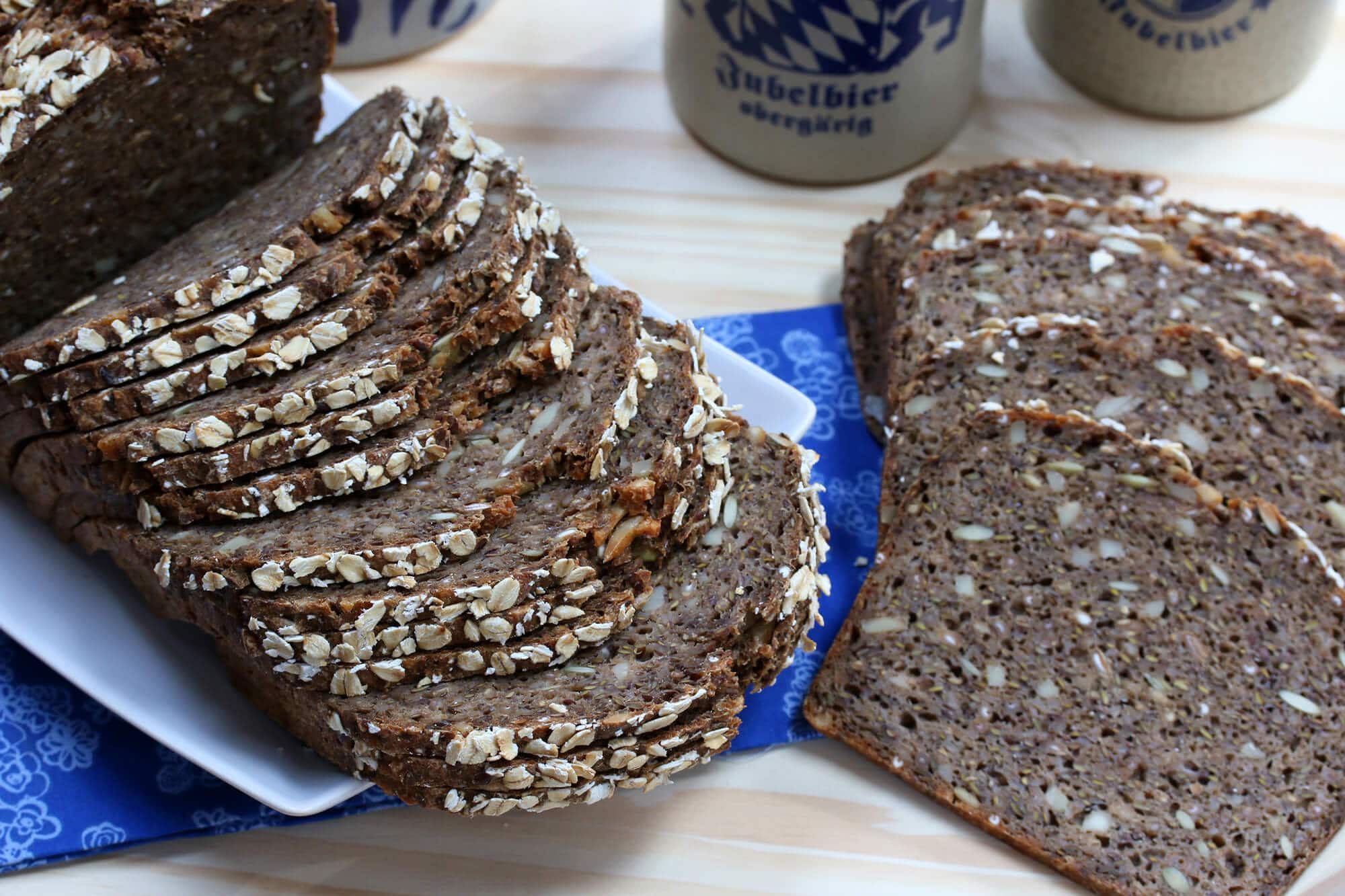
For more delicious breads from around the world be sure to try my:
- German Bread (Vollkornbrot)
- Lavash
- Injera
- Dosa
- Naan Bread
- Sourdough Naan
- Sourdough English Muffins
- Crumpets
- Olive Rosemary Focaccia
- Skillet Cornbread
Save This Recipe
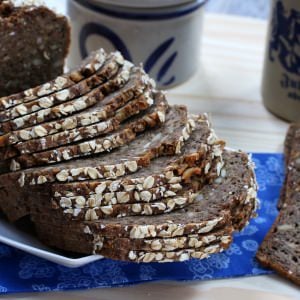
Danish Rye Bread (Rugbrød)
Ingredients
- 2 cups lukewarm water
- 2 teaspoons dry active yeast
- 2 tablespoons sugar
- 2 1/2 cups dark rye flour
- 3/4 cup all-purpose flour
- 1 3/4 cup cracked rye berries (very briefly pulse whole rye berries in a strong blender or food processor until they're broken up into coarse pieces OR smash them in a heavy duty bag with a meat mallet or other heavy object)
- 1/2 cup whole rye berries
- 1 1/4 cup whole flaxseeds
- 1 1/3 cup sunflower seeds or combination of sunflower seeds ,pumpkin seeds and/or chopped almonds
- 3 teaspoons salt
- 1 cup dark beer (see note)
- 1 cup buttermilk or kefir (vegan: 1 cup almond milk mixed with 2 tablespoons cider vinegar) (I often use homemade kefir in place of buttermilk)
- Traditional rolled oats for sprinkling
Instructions
- Stir the yeast and sugar into the lukewarm water and let sit for 10 minutes until the yeast is frothy.
- Combine all the dry ingredients in the bowl of a stand mixer. Add the yeast mixture, beer and buttermilk. Stir to combine.Fit the stand mixer with a dough hook and knead on the bread setting ("2") for 10 minutes. The dough will be very sticky, loose and not remotely malleable (ie, incapable of being shaped).Scoop the dough into a very large non-metallic bowl with plenty of head space (the dough will bubble up). Cover loosely with plastic wrap and let it rest in a warm place (room temperature) for 24-48 hours, depending on how sour you want the bread to be (be sure to ferment it for at least 24 hours to ensure enough of the liquid is absorbed). If you're only letting it ferment for 24 hours we recommend first soaking the whole rye berries overnight before using them (drain thoroughly).
- Line a 9x5x3 inch bread loaf pan with parchment paper (SEE NOTE). Preheat the oven to 350 degrees F.Scoop all of the dough into the lined bread pan, pressing down as needed. (It's a lot of dough but it will fit.) Brush the top with water and sprinkle over evenly with the rolled oats.Bake on the middle rack for 100-120 minutes or until the center is done. For best and most accurate results use an instant read thermometer and aim for an internal temperature of 210 degrees F.Let the loaf cool for 5 minutes before removing it from the pan. Let the loaf cool completely before slicing. Keep stored in an airtight container. To prolong its shelf life I recommend storing it in the refrigerator or freeze part of it if you know it will take you a while to go through it.
Notes
* You can substitute water or more buttermilk for the beer
Nutrition
Originally published on The Daring Gourmet January 28, 2016




















Would I need to double the recipe for a pullman loaf pan ?
Hi Amber, that’s probably pretty close, you may have a little excess dough leftover.
Your bread looks AMAZING! I can’t wait to make this. Did you use golden or brown flaxseeds please? With regard to the dark beer, do you mean something like a stout or Guinness please?
Thank you, Thuy! I usually use brown flaxseeds but you can also use golden. I recommend a dark, sweet beer – ale, stout, a German type beer, etc. If you prefer the flavor can also use light beer instead. Happy baking!
HELP!
I’m in the process of making this dough now but vegan (no kefir/no buttermilk/beer) and also without flaxseed or all purpose flour. I was unable to find rye berries locally as well so no cracked rye berries. I used:
735ml water with yeast and sugar (subbed 235ml water in place of beer)
240ml vegan kefir sub
350g dark rye flour.
180g pumpkin/sunflower seed mix with salt
Needless to say, when mixed it all together, it was very very wet. Because I left out the 745g of rye berries and flaxseed, I kept adding flour until I reached a consistency close to what I observed in your photos and other videos on YouTube. In the end, it took about 630g of flour to this wet mixture to reach close to the right consistency. It still looks and feels too wet. I let it sit anyways in a large bowl. For about 4 hours, it was covered loosely at room temp and almost doubled in size. Overnight I put a plate over it so it wouldn’t spill out. When I came out to it this morning it looked deflated, and rather than double, lost about half of that, so it’s roughly 75% it’s original size now. After some reading, I put in a splash of warm water and a splash of flour, and mixed it up. When I did this, It was still very airy inside and I could hear the bubbles collapsing. I want to let it sit for another 24 hours before baking, but I need guidance as to whether or not I should be feeding it and stirring it or leave it sit, even though its slightly deflated. It’s still VERY wet and I just don’t know what to do.
Thanks
Hi Nick, those are very significant changes to the original recipe so I’m afraid I can’t really add much in the way of guidance. What I can say though is that the batter is supposed to be quite wet. It will not remotely resemble regular bread dough that you can turn out onto the counter and need. This bread dough is more of a very thick batter that you scoop into the bread pans. I wouldn’t let it ferment for “too” long otherwise you’ll end up with an excessive amount of air bubbles resulting in a bread that will collapse in the oven or have large holes or “tunnels” throughout.
Made your bread at request of my son for “Rugbrod.” He is a university professor who took his students on a trip to Denmark for a study exchange program. He later returned to Denmark alone for a month, eating this type of bread daily, and upon returning to the states, was disappointed he could not find it locally.
He absolutely loves this bread and is begging me to make it again, stating it is the only bread he will eat : )
So, thank you for sharing this great recipe/method of Rugbrod!
That’s a compliment indeed, Louise! I’m thrilled that your son enjoyed it so much – thank you for the feedback!
Could I use dark liquid malt for the beer? And how much do you think if I can?
I’m just making this now, and I think my loaf pans are a little different (8-1/2 x 4-1/2 x 2-1/2″), but even still – I don’t see how all this dough would fit in one pan. I think I may bake it in two pans. Any recommendations on how to adjust cooking times or temperatures?
Also, I don’t have a thermometer. Is there any way to know when to take it out? I was just going to do the full 2 hours, as my oven can be a little slow sometimes.
Hi April, I use a 9x5x3 pan and the dough fits. If you use two 8-1/2 x 4-1/2 x 2-1/2″ pans the loaves will be too flat. If that’s the only size you have I recommend filling it to capacity and discarding the remaining batter (or finding something creative to do with it) so you have a full-sized loaf. Baking time will probably be slightly less but yes, I’d still aim for close to 2 hours. Without a thermometer you may just need to remove the loaf and cut into the center of it to see if it’s done and if it isn’t then pop it back in in the oven.
Thanks! That’s very helpful. :) I’m looking forward to seeing how this works out.
I soaked 1/2 cup whole rye berries overnight. The recipe calls for 1/2 cup whole berries (drained) – do I take the 1/2 cup from the soaked berries (which have doubled in size) or do I use the entire amount of berries that have resulted from the soaking 1/2 cup overnight?
Hi Sue, that’s 1/2 cup prior to soaking, so you’ll use the entire amount.
Hi, I need your advice. I just made dough and scooped it into a bowl. I see that dough is kind of liquid, not like water of course, rather like creamy oatmeal. Is it ok? I worry, because I couldn’t grain the rye berries properly. Which kind of dough texture should I have, when it will be ready for backing?
Hi Sveta, oatmeal is a good description, it should be like a very, very thick oatmeal. It sounds like you’ve got it right. Happy baking and let us know how it turned out!
Hi Kimberly! The result was great, especially taking in account that it was the first selfmade bread in my whole life! It was kind of wet inside though I baked it almost 3 hours before the gaining of proper temperature inside. As a result the crust was very hard, but I solved this problem by using a plastic bag over a day. Looks like it redistribute the moisture and the crust became softer. I also googled a bit and found that i should pay higher attention to flour. I took fullcorn rye flour instead of rye flour and high quality wheat flour instead of all-purpose flour. I am from Russia and now living in Germany, so all-purpose flour is kind of something special in both countries. I realized that it can be a reason why my bread looks like uncooked inside. So, I found right flour and I am going to make one more try, let’s see.
Hi, how much water should I mix in with the yeast and sugar?
Hi Stephanie, 2 cups of lukewarm water.